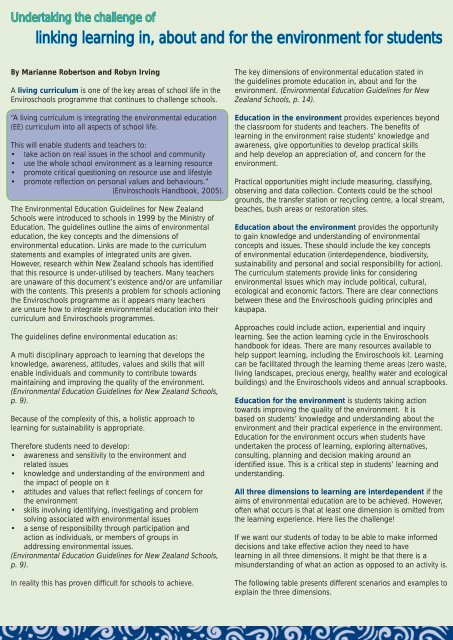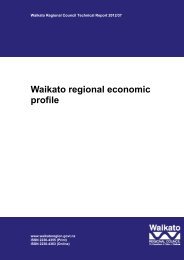Enviroschools Newsletter no. 11 - May 2007 - Waikato Regional ...
Enviroschools Newsletter no. 11 - May 2007 - Waikato Regional ...
Enviroschools Newsletter no. 11 - May 2007 - Waikato Regional ...
Create successful ePaper yourself
Turn your PDF publications into a flip-book with our unique Google optimized e-Paper software.
Undertaking the challenge of<br />
linking learning in, about and for the environment for students<br />
By Marianne Robertson and Robyn Irving<br />
A living curriculum is one of the key areas of school life in the<br />
<strong>Enviroschools</strong> programme that continues to challenge schools.<br />
“A living curriculum is integrating the environmental education<br />
(EE) curriculum into all aspects of school life.<br />
This will enable students and teachers to:<br />
• take action on real issues in the school and community<br />
• use the whole school environment as a learning resource<br />
• promote critical questioning on resource use and lifestyle<br />
• promote reflection on personal values and behaviours.”<br />
(<strong>Enviroschools</strong> Handbook, 2005).<br />
The Environmental Education Guidelines for New Zealand<br />
Schools were introduced to schools in 1999 by the Ministry of<br />
Education. The guidelines outline the aims of environmental<br />
education, the key concepts and the dimensions of<br />
environmental education. Links are made to the curriculum<br />
statements and examples of integrated units are given.<br />
However, research within New Zealand schools has identified<br />
that this resource is under-utilised by teachers. Many teachers<br />
are unaware of this document’s existence and/or are unfamiliar<br />
with the contents. This presents a problem for schools actioning<br />
the <strong>Enviroschools</strong> programme as it appears many teachers<br />
are unsure how to integrate environmental education into their<br />
curriculum and <strong>Enviroschools</strong> programmes.<br />
The guidelines define environmental education as:<br />
A multi disciplinary approach to learning that develops the<br />
k<strong>no</strong>wledge, awareness, attitudes, values and skills that will<br />
enable individuals and community to contribute towards<br />
maintaining and improving the quality of the environment.<br />
(Environmental Education Guidelines for New Zealand Schools,<br />
p. 9).<br />
Because of the complexity of this, a holistic approach to<br />
learning for sustainability is appropriate.<br />
Therefore students need to develop:<br />
• awareness and sensitivity to the environment and<br />
related issues<br />
• k<strong>no</strong>wledge and understanding of the environment and<br />
the impact of people on it<br />
• attitudes and values that reflect feelings of concern for<br />
the environment<br />
• skills involving identifying, investigating and problem<br />
solving associated with environmental issues<br />
• a sense of responsibility through participation and<br />
action as individuals, or members of groups in<br />
addressing environmental issues.<br />
(Environmental Education Guidelines for New Zealand Schools,<br />
p. 9).<br />
In reality this has proven difficult for schools to achieve.<br />
The key dimensions of environmental education stated in<br />
the guidelines promote education in, about and for the<br />
environment. (Environmental Education Guidelines for New<br />
Zealand Schools, p. 14).<br />
Education in the environment provides experiences beyond<br />
the classroom for students and teachers. The benefits of<br />
learning in the environment raise students’ k<strong>no</strong>wledge and<br />
awareness, give opportunities to develop practical skills<br />
and help develop an appreciation of, and concern for the<br />
environment.<br />
Practical opportunities might include measuring, classifying,<br />
observing and data collection. Contexts could be the school<br />
grounds, the transfer station or recycling centre, a local stream,<br />
beaches, bush areas or restoration sites.<br />
Education about the environment provides the opportunity<br />
to gain k<strong>no</strong>wledge and understanding of environmental<br />
concepts and issues. These should include the key concepts<br />
of environmental education (interdependence, biodiversity,<br />
sustainability and personal and social responsibility for action).<br />
The curriculum statements provide links for considering<br />
environmental issues which may include political, cultural,<br />
ecological and eco<strong>no</strong>mic factors. There are clear connections<br />
between these and the <strong>Enviroschools</strong> guiding principles and<br />
kaupapa.<br />
Approaches could include action, experiential and inquiry<br />
learning. See the action learning cycle in the <strong>Enviroschools</strong><br />
handbook for ideas. There are many resources available to<br />
help support learning, including the <strong>Enviroschools</strong> kit. Learning<br />
can be facilitated through the learning theme areas (zero waste,<br />
living landscapes, precious energy, healthy water and ecological<br />
buildings) and the <strong>Enviroschools</strong> videos and annual scrapbooks.<br />
Education for the environment is students taking action<br />
towards improving the quality of the environment. It is<br />
based on students’ k<strong>no</strong>wledge and understanding about the<br />
environment and their practical experience in the environment.<br />
Education for the environment occurs when students have<br />
undertaken the process of learning, exploring alternatives,<br />
consulting, planning and decision making around an<br />
identified issue. This is a critical step in students’ learning and<br />
understanding.<br />
All three dimensions to learning are interdependent if the<br />
aims of environmental education are to be achieved. However,<br />
often what occurs is that at least one dimension is omitted from<br />
the learning experience. Here lies the challenge!<br />
If we want our students of today to be able to make informed<br />
decisions and take effective action they need to have<br />
learning in all three dimensions. It might be that there is a<br />
misunderstanding of what an action as opposed to an activity is.<br />
The following table presents different scenarios and examples to<br />
explain the three dimensions.

















